
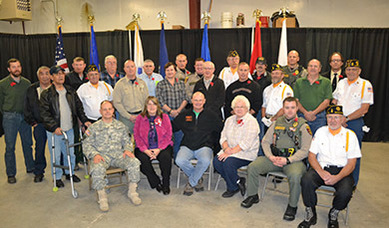 Above: At a Veterans Day luncheon Thursday in Grand Rapids, DNR Commissioner Tom Landwehr (center) met with members of the local veterans community, along with current and former DNR employee armed services members.
Below: The "table for one" was set in honor of service members who are missing in action. Each item is symbolic, including an inverted glass for the missing and salt representing the tears of their families.
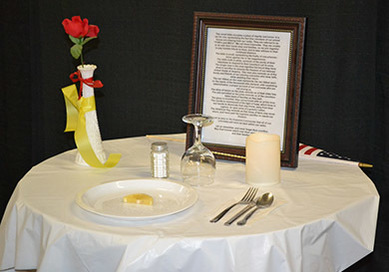
The U.S. Capitol Christmas tree made its final Minnesota stops last week on its way to Washington, D.C.
The tour stopped in West St. Paul Thursday, where DNR foresters and elected officials participated in a U.S. Forest Service-sponsored event.
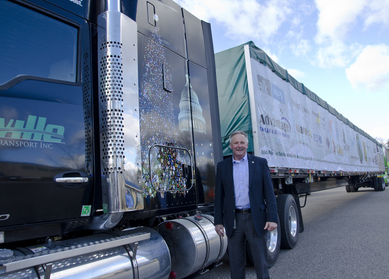 Forrest Boe, DNR Forestry Division director, stood next to the 100-foot trailer carrying the U.S. Capitol Christmas tree, a white spruce harvested from northern Minnesota's Chippewa National Forest.
Forestry Division Director Forrest Boe, along with U.S. Sens. Amy Klobachar and Al Franken, attended the event at Garlough Environmental Magnet School, which has a DNR school forest.
In a message to state employees last week, Lt. Gov. Prettner Solon announced that this year's Combined Charities Campaign raised more than $681,500 for Minnesota charities. The official campaign ended Oct. 31, but you can still make a pledge through payroll deduction.
Fisheries experts will examine one of Minnesota’s lesser-known native game fish populations, coaster brook trout, as the DNR prepares to update its Lake Superior management plan in the coming months.
Migratory coaster brook trout were once widely distributed along the North Shore and have spawned in Lake Superior tributaries since long before Pacific salmon and steelhead were introduced to the big lake. “Coasters” were popular among anglers until the late 1800s when stocks declined due to habitat degradation and overfishing. Since then, the fish have been relatively scarce in Minnesota waters – and an experimental DNR stocking program was halted in 1987 due to poor returns of stocked fish.
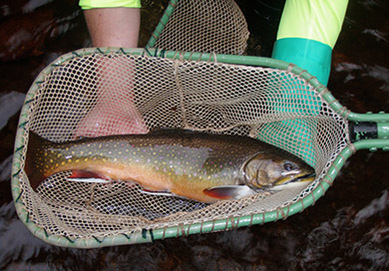 Minnesota’s native coaster brook trout live part of their lives in coastal areas of Lake Superior and spawn in the lower reaches of North Shore tributaries. Although they are genetically similar stream-dwelling brook trout, “coasters” often grow larger. This fish was sampled by the DNR last fall and measured nearly 21 inches.
To protect the state’s remaining coaster brook trout, the DNR enacted restrictive regulations in 1997. These include a 20-inch minimum length and one-fish limit below posted boundaries on Lake Superior tributaries, plus a closed season after Labor Day to prevent harvest during the fall spawn.
Is the population rebounding? “Progress has been slow, but the regulations seem to have helped,” said Josh Blankenheim, DNR Lake Superior anadromous specialist. He assessed 26 streams from Duluth to Grand Portage last fall and sampled several large brook trout in the 20-inch range. Still, Blankenheim offers cautious optimism. “We just don’t have a lot of good spawning habitat for coaster brook trout in North Shore streams. In these lower reaches, it’s dominated by large substrate, there’s not a lot of groundwater and it tends to be rather warm.”
A week ago, Blankenheim sent tissue samples from some of last fall's larger fish to Loren Miller, DNR fisheries geneticist. Miller will determine whether or not they are related to Isle Royale brook trout strains stocked in recent years by the Grand Portage Band of Chippewa on reservation waters near the Canadian border.
Past analysis has shown that most coaster brook trout sampled on the North Shore are genetically unique to Minnesota. “By and large, these are Minnesota strain fish," said Blankenheim. "They’re not really coming from stocking efforts by Grand Portage or stray fish from Isle Royale.”
For now, the DNR has no plans to revisit stocking coaster brook trout, which could jeopardize genetic integrity of the population. Instead, conservative fishing regulations and protection of North Shore stream habitat may help nature takes its course.
Ten new Minnesota Department of Natural Resources conservation officers are in their field stations following 16 weeks of field training.
“These officers were recently added to the ‘thin green line’ sworn to serve the citizens by providing law enforcement and education programs,” said Col. Ken Soring, DNR Enforcement Division director. “We are proud to have them aboard and look forward to what they can accomplish by working with the communities they serve to.”
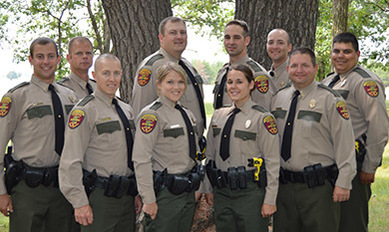 Front, L-R: Nick Klehr (Litchfield), Beau Shroyer (Remer), Chelsie Leuthardt (Bloomington), Hannah Cowden (Warroad #2), Marc Hopkins (Tower).
Back L-R: Eric Benjamin (Warroad #1), Bill Landmark (Moorhead), Jim Van Asch (International Falls #2), Nick Prachar (Baudette #1), Joe Kulhanek (Hastings).
The 16-week field training followed the 12-week Conservation Officer Academy at Camp Ripley. During field training the recruit is paired with an experienced conservation officer to gain on-the-job training for natural resources management and law enforcement-related activities before receiving their initial field station assignment.
“When our recruits finish our academy, we know that they have received the best training available anywhere, but we take it a step further with intensive field training with an experienced field officer,” said Soring. “We pride ourselves on selecting the best people available and giving them the best training in order to provide the highest quality service possible to our citizens who depend on us to protect and preserve our natural resources and help maintain the quality of life we have in Minnesota.”
Despite the new officers, 21 of DNR Enforcement’s 155 field stations remain open.
 The annual Governor's Deer Hunting Opener was held in Bemidji last week and featured remarks by DNR Commissioner Tom Landwehr. Paul and Babe were exempt from the state's blaze orange clothing requirement. Next year's event is planned for the town of Mountain Iron near George Washington State Forest.
|